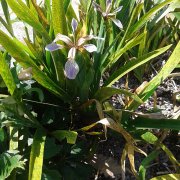Care of the rhizomatous plant Iris foetidissima or Roast-beef plant |
|
The genus Iris, family Iridaceae, comprises 300 species of rhizomatous and bulbous plants native to temperate regions of Europe, Asia, Africa and America. Some species are: Iris foetidissima, Iris orientalis, Iris germanica, Iris pseudacorus, Iris unguicularis, Iris pumila, Iris xiphium, Iris lutescens, Iris aucheri. Common names: Stinking gladwin, Roast-beef plant, Gladwin iris, Stinking iris. This species is native to the western Mediterranean, the Azores islands, North Africa, and western Europe. They are rhizomatous herbaceous plants that reach 80 cm (31.49") in height. The evergreen, deep green, sword-shaped leaves give off an unpleasant odor if touched. The attractive flowers are lilac with yellow tones and mottled. They bloom from mid-spring to early summer. The fruits, yellow or red, can be decorative. Stinking iris is used to form groups in undergrowth, next to ponds and pools, in rockeries or combined by ornamental grasses. It's ideal for coastal gardens because of its resistance to the sea breeze. Iris foetidissima can grow in full sun (it will flower less), semi-shade or shade exposures. It resists frost down to -12 ºC (10.4 ºF). The soil should be well drained, slightly loamy, and contain organic matter. The rhizomes are planted in the fall. Roast-beef plant resists drought so it has to be watered moderately, waiting for the soil to dry out before adding more water. It can withstand a few days of drought. Fertilize with compost in late winter. Prune intensively at the end of flowering. Iris foetidissima is a resistant plant to the most common pests but sensitive to excess humidity. Stinking gladwin propagates from seeds sown in spring or autumn and by division of the rhizome in autumn. |
Images of the rhizomatous plant Iris foetidissima or Roast-beef plant |
Find plants
Iris foetidissima or Roast-beef plant | Care and Growing
© 2025 FavThemes

